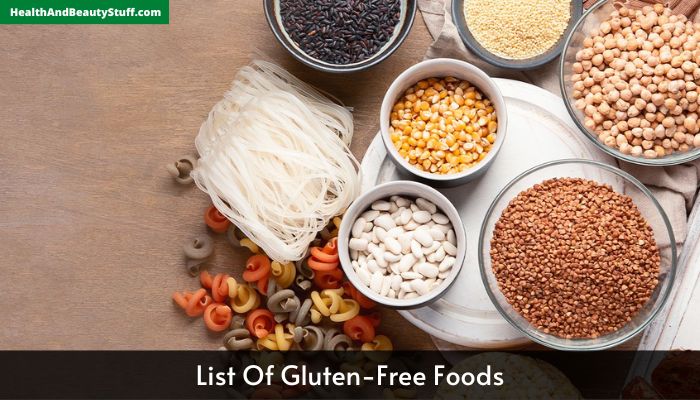Gluten, a protein found in wheat, barley, and rye, can cause health issues for individuals with celiac disease or gluten sensitivity.
If you are following a gluten-free diet, it’s important to know which foods are safe to consume. Thankfully, there are plenty of delicious and nutritious gluten-free options available.
In this article, we will explore a comprehensive list of gluten-free foods to help you eat well and live well.
What is Gluten?
Gluten is a composite protein made up of gliadin and glutenin. It gives elasticity to dough and helps it to rise.
People with celiac disease have an immune response to gluten which damages the lining of the small intestine.
Others may have non-celiac gluten sensitivity, experiencing symptoms similar to those with celiac disease without the intestinal damage.
Gluten-Free Grains and Flours
- Rice: Rice is a versatile and naturally gluten-free grain available in various forms—white, brown, basmati, or jasmine. It can be used as a side dish, in stir-fries, or as a base for grain bowls.
- Quinoa: Quinoa is a complete protein and a great source of dietary fiber. Use it as a substitute for rice or in salads and soups.
- Corn: Corn is gluten-free and can be enjoyed in various forms like cornflour, cornmeal, or as a side dish.
- Oats: While oats are naturally gluten-free, they’re often contaminated during processing. It’s important to look for certified gluten-free oats when purchasing.
- Buckwheat: Despite its name, buckwheat doesn’t contain wheat. It’s a pseudo-cereal that can be used as an alternative to wheat.
- Amaranth: Amaranth is a nutritious gluten-free grain that can be boiled, popped, or ground into flour for baking.
- Sorghum: Sorghum is a gluten-free grain that is rich in fiber and antioxidants. It can be used in porridge, baked goods, or as a thickener.
- Millet: Millet is a gluten-free grain that is often used to make bread, porridge, or as a base for salads.
Vegetables and Fruits
- Leafy Greens: Spinach, kale, Swiss chard, and other leafy greens are naturally gluten-free and packed with vitamins and minerals. Add them to salads, smoothies, or stir-fries.
- Cruciferous Vegetables: Broccoli, cauliflower, Brussels sprouts, and cabbage are delicious and gluten-free. Roast them, steam them, or add them to stir-fries.
- Root Vegetables: Sweet potatoes, carrots, beets, and parsnips are gluten-free and make excellent side dishes or additions to soups and stews.
- Fruits: All fresh fruits are naturally gluten-free and can be enjoyed as a snack or incorporated into smoothies, desserts, or salads.
Protein Sources
- Lean Meats: Fresh, unprocessed meats like chicken, turkey, beef, and pork are gluten-free. Avoid breaded or processed meats.
- Fish and Seafood: Fish and seafood are gluten-free and rich in omega-3 fatty acids. Enjoy grilled fish, shrimp, salmon, or tuna steaks.
- Eggs: Eggs are a versatile and nutritious source of protein. Have them scrambled, boiled, baked, or in omelets.
- Legumes: Beans, lentils, and chickpeas are naturally gluten-free and provide a good amount of fiber and protein. Use them in salads, soups, or stews.
- Nuts and Seeds: Almonds, cashews, walnuts, chia seeds, flaxseeds, and pumpkin seeds are all gluten-free and can be enjoyed as a snack, in salads, or in baked goods.
Dairy and Alternatives
- Milk: Dairy milk and its products like yogurt and cheese are naturally gluten-free. However, some processed dairy products may contain gluten as additives, so it’s important to read labels carefully.
- Plant-Based Milk: Almond milk, coconut milk, soy milk, and rice milk are gluten-free alternatives to dairy milk.
- Plant-Based Yogurts: Coconut milk yogurt, almond milk yogurt, and soy milk yogurt are tasty and gluten-free options.
- Cheeses: Most natural cheeses are gluten-free, but processed cheeses may contain gluten as additives. Choose cheeses without added ingredients or artificial flavors to be safe.
Snacks and Treats
- Nuts and Seeds: Roasted nuts, trail mix, and nut butter are great gluten-free snacks.
- Popcorn: Air-popped popcorn is a delicious and gluten-free snack that can be enjoyed as is or seasoned with various flavors.
- Rice Cakes and Corn Cakes: These crunchy snacks come in various flavors and are gluten-free alternatives to crackers or chips.
- Dark Chocolate: Pure dark chocolate without any added ingredients is usually gluten-free. Check labels to be sure.
- Gluten-Free Baked Goods: There are many gluten-free flour blends available that can be used to make delicious, homemade gluten-free bread, muffins, cookies, and cakes.
FAQ
What are some common gluten-containing foods?
Are oats gluten-free?
Is gluten-free food healthier?
In conclusion, living a gluten-free lifestyle doesn’t mean you have to miss out on delicious and nutritious food. With the wide variety of gluten-free options available, you can eat well and live well.
By incorporating whole grains, vegetables, fruits, proteins, and alternative sources of dairy into your diet, you can enjoy a diverse and satisfying range of meals.
Remember to always read labels carefully and consult a healthcare professional or registered dietitian if you have any concerns about your gluten-free diet.

